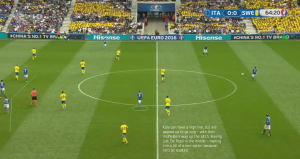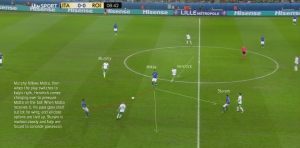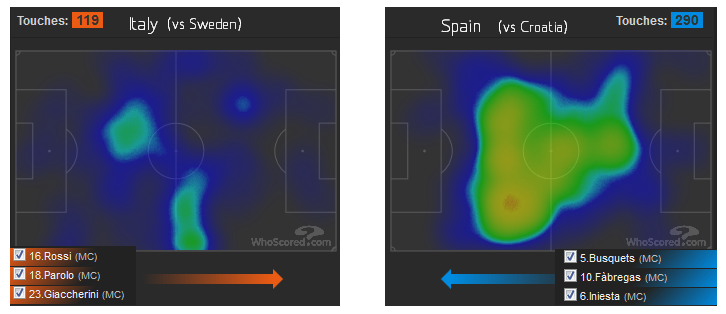With a suspected tough start against Belgium, Conte drew on an expected and trusted system, fielding the 5-3-2 – which remained the case throughout the group stage. The only slight surprise was the inclusion of Parolo and omission of Florenzi in the Belgium game, who was then reintroduced and left back against Sweden at the expense of Darmian. Giaccherini managed to cement a place in the starting lineup and De Rossi, as expected got the nod ahead of Motta. Eder and Pelle proved themselves to be the preferred partnership up front. The third game, against Ireland, was somewhat experimental with the team having already topped the group – although interesting nonetheless. Despite a great start to the tournament, there was common themes (good and bad) for Conte to consider and work upon going into the knock-out stages.
Defensively sound
The back three + Buffon was pretty much set in stone from before the first match, and this was billed as being the nation’s big strength. Nothing has really changed here. In the first game against Belgium, we were treated to some of Bonucci’s talents coming to the fore – the pinnacle of which probably being his long-ball assist for Giaccherini’s goal. We knew that he is the ball-playing defender, and that his range of passing is excellent, but we didn’t expect this to be demonstrated (and neglected by Belgium) so quickly in the tournament. Bonucci was given plenty of time to stand on the halfway-line and pick out Giaccherini, who made a good run in behind and Ciman switched off, for the first goal after half an hour. It was a bit symptomatic of Belgium’s start – they didn’t harass Conte’s side on the ball, they left too much time and space in midfield, and they looked flat-footed & passive without the ball. As we’ll mention later, Italy can struggle if routes to pass through the middle or out from the back are cut off, but they never really had this problem in the opening game, especially as their wing-backs weren’t really pressured either when receiving the ball directly. Chiellini was often able to chose who he wanted to pass to, sometimes ignoring de Rossi and attempting more aggressive balls through midfield or linking with Giaccherini on the left. Italy were able to keep a high line, and Belgium (Lukaku in particular) never really took advantage of running in behind.
In the games against Sweden and Ireland, it was more difficult for Italy’s defence in terms of keeping the ball and dictating the initiation of attacks. They were slower in moving the ball between themselves, and with more pressure on them from the opposition it meant they had less opportunity to pick passes or start effective transitions. With high wing-backs it is difficult to have an out-pass that gains an advantage, because once they are back to offer a lateral pass to their defender there is an opportunity for opponents to press them and close them down. Before the tournament, Conte was also vocal about his team, including wing-backs, pressing high up the pitch. This is difficult if they are needed in their own half to consistently provide an option for the defence with the ball. No-one really had the luxury of pushing up and getting space like they did in the Belgium game. Despite the slightly disjointed and uninspiring nature of the second two games, the defensive aspect of Italy’s performance was solid. Sweden didn’t have a shot on target in the game, as Italy made twice as many tackles and shut off access to their penalty area. As usual, it was the compactness and discipline of the team as a whole when out of possession that prevent any real dramas. Against Ireland it was even more difficult, as they pressed heavily and allowed Italy no time on the ball. Bernardeschi gave the ball away a fair amount on the right, and these avenues down the wings weren’t a very viable option for the back-line if they wanted to retain possession. Every Italian player was marked as Ireland pushed up off the ball. There were examples of Bonucci losing the ball under pressure, and then also of his long-range passes going astray, with no accurate way out with the ball. The main aim of the game for Bonucci appeared to become that of not getting booked and picking up a suspension for the first knock-out match, as Italy fans cringed when he went in for a tackle.
Italy’s pivotal midfield
Its been De Rossi’s job to take up the role in front of the defence for Conte, replaced by Motta for the Ireland game, as the pivot filling the holes left by Marchisio and Verratti’s injuries. We’ve seen it numerous times this season at Juventus in the same 3-5-2 system, with Marchisio being the link and starting attacks by coming deep for the ball and using his range of passing. De Rossi has the opportunity to do that for the national side now, not just doing the dirty work of tackling and intercepting, but instigating attacks and helping in transitional phases. The notable point about this is that he’s on his own. Particularly if Italy’s defensive line us pushed back further than it would like, De Rossi is normally the only option in the middle of the pitch for their defence to pass to. This is a problem, and one that can be jumped upon by opponents. Ball retention is a cumulative effect, and each pass becomes more difficult if players are marked or pressured. If De Rossi is given little time or space, and his midfield team-mates Parolo and Giaccherini are high up the pitch, the ball has to go long. Although Italy might be geared up to receive long passes up the pitch, its still a low percentage pass. Against Belgium it was easier for Italy to play through midfield because Wilmots’ side didn’t press or work particularly hard out of possession, so Italy had passing routes open for the likes of Bonucci, Chiellini and De Rossi – wide or central. Therefore, the fact that Fellaini was sometimes placed on De Rossi was pretty ineffectual. Against Sweden he was bothered by Guidetti, but it was more the fact that Italy tended to abandon the middle of the pitch, leaving him with less options. Ireland were very high-energy and pressed well, not just with Murphy on Italy’s pivot (Motta this time), but also Hendrick coming over from the right. Its a decision that Conte needs to make – do Italy try and play through Spain in the next round, or do they use the long ball to Pelle and diagonals out wide. This is something that Italy would benefit from being adapted during the game – a plan B if you want to call it that. They have to be aware that even if they get men supporting De Rossi on the ball, they may be marked and space may be limited.
The other two midfielders – presumably Parolo and Giaccherini, in the game against Spain, must be responsive to the transitional stage of the play. Aside from being box-to-box and supporting the wing-backs, they need to actively effect the space in the middle of the pitch. Giaccherini likes to link with the left-back and head out to the left wing, and the same to some extent with Parolo on the opposite side, but they have to be aware that this neglects the space in the middle of the pitch. Against Spain, who may push their defensive line up, this could leave them undesirably exposed if they lose possession – and players like Iniesta and Silva/Morata dropping deep can take advantage of space here. The more each team attempts to push the defensive line up, the more compact it becomes in midfield, and the more availability to utilise wing-backs and runners. With Candreva fit, Conte might have gone for Florenzi over Parolo or Giaccherini in midfield, but this now looks unlikely. One thing that Italy did very well, particularly against Sweden, was keeping their structure and shape off the ball. They moved across the pitch as a unit, and tracked the position of the ball extremely well at all times. This allowed them to allocate men to the correct areas and shut of any danger from Sweden’s attacks. This was partly because Sweden’s passing was poor and their transitions were slow, which most likely won’t be the case with Spain. Italy will need to work hard mentally and physically, but Conte has a job on his hands to get his players covering midfield spaes efficiently.
Attacking options
Pelle and Eder have been the favourable two for Conte, and that may very well not change, but Italians were given a glimpse of perhaps what they have missed so far. The introduction of Insigne late in the last game showed how effective it can be to have someone changing the pace of the attack. He picked up the ball, ran with it, cut inside and generally put new life into Italy’s attack. After hitting the post within minutes of coming on against Ireland, he was making a claim for a regular place in the side. Despite his great goal against Sweden, Eder’s impact has been limited, and Conte must have thoughts creeping in to appease the doubters and give Insigne a start as a second striker. The questions surrounding his inclusion would be, will his pace and ability on the ball be enough to trouble Spain – and will this be offset by any defensive-minded work he has to do. Will his link-up play with Pelle be good enough to make him a viable option? It would be nice to see him introduced, if not starting, because he has the potential to stretch Spain’s defence and run behind. The energy and willing of Zaza will also be a possibility for Conte, with the striker showing characteristic hard-work and the occasional crack of a shot to worry the keeper. Against Ireland he was often found wandering back into his own half, looking for a ball to be played into him, but his tendency to play with his back to goal can be frustrating at times. However, if Italy end up foregoing the route through midfield, and want to go long with their passing upfield, Zaza may be the most effective option to partner Pelle. All-in-all, Italy’s group games haven’t really told us much that we didn’t already know, and the road through the knock-out stages will be a predictably bumpy one for the Azzurri. Candreva’s absence may well lose some of the threat from the right, and his crosses and persistence on the side will now fall into the responsibility of someone else.
Conclusion
After a surprisingly struggle-free opener against Belgium, Conte’s side became increasingly troubled by their opponents and own lack of impetus. Against Sweden they remained strong and structurally resolute without the ball, defending well and eventually scoring a good individual winner through Eder, but they lacked the fire and energy that took them through the previous match. Ireland played very well, and Conte made changes for the final group game, but this didn’t give them any real momentum to take through to the next round. When they were pressed on the ball and shut-off from working the ball around, Italy looked rushed and slightly aimless. Hope and variety seems to be there in tough situations from the bench, but can Italy afford to get to this stage of the game before trying to impose the exuberance and threat of someone like Insigne? It will be interesting to find out whether they have the resilience and adaptability to overcome an opponent like Spain, and will they be able to make up for a shortfall in individual quality once again.




